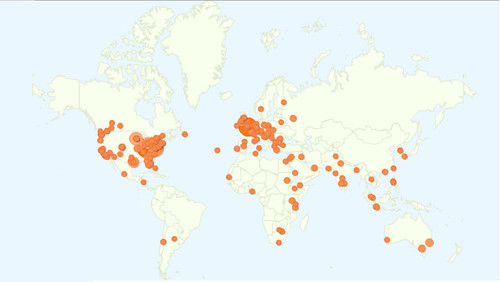I'm sure the data on oil production has a lot of caveats that come with it, but I'm not interested in those details. I'm interested in how far off my perception of oil production is from reality.
A few things really jumped out at me. I knew the US produced a lot of oil but had no idea it produced 9 million barrels per day. I've always thought OPEC were THE big ones. However, that doesn't seem to be the case - or at least to a lesser extent than I thought.
The map of oil production by country is below. I haven't included a legend but I have included the list (ranking) of countries at the bottom of this post. The darker the color the more oil the country produces. I've highlighted the 12 OPEC countries with a gold line and a shadow. In this map, OPEC countries don't appear all that special, just a random group of countries that produce significant amounts of oil.
But gas is still $3.50 a gallon. That's a lot of Ethiopian Birr.

Oil Production and Rank (2009)
1 Russia 9,932,000
2 Saudi Arabia 9,764,000
3 United States 9,056,000
4 Iran 4,172,000
5 China 3,991,000
6 Canada 3,289,000
7 Mexico 3,001,000
8 United Arab Emirates 2,798,000
9 Brazil 2,572,000
10 Kuwait 2,494,000
11 Venezuela 2,472,000
12 Iraq 2,399,000
13 Norway 2,350,000
14 Nigeria 2,211,000
15 Algeria 2,125,000
16 Angola 1,948,000
17 Libya 1,790,000
18 Kazakhstan 1,540,000
19 United Kingdom 1,502,000
20 Qatar 1,213,000
21 Indonesia 1,023,000
22 Azerbaijan 1,011,000
23 India 878,700
24 Oman 816,000
25 Argentina 796,300
26 Malaysia 693,700
27 Colombia 686,600
28 Egypt 680,500
29 Australia 589,200
30 Sudan 486,700
31 Ecuador 485,700
32 Syria 400,400
33 Equatorial Guinea 346,000
34 Thailand 340,900
35 Vietnam 338,400
36 Yemen 288,400
37 Taiwan 276,800
38 Republic of the Congo 274,400
39 Denmark 262,100
40 Gabon 241,700
41 Turkmenistan 197,700
42 South Africa 191,000
43 Germany 156,800
44 Trinidad and Tobago 151,600
45 Peru 148,000
46 Italy 146,500
47 Brunei 146,000
48 Japan 132,700
49 Romania 117,000
50 Chad 115,000





